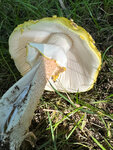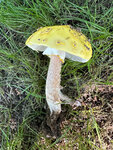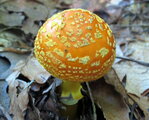






All of our seemingly endless summer rains have produced some interesting fungal fruitings!
Typically, we have a mid-summer drought, or worse, and can only collect fall species, but this year, we can see what a good wet summer brings to our forest floor.
We are witnessing many mushrooms appearing but from a limited list of species. Therefore, it’s a good time to learn about them, because you can see young and old ones over and over again and develop a solid understanding of each of them.
There is a living textbook going on out there in the woods and, interestingly enough, most of them are all symbiotic and have a mycorrhizal growth pattern with neighboring trees.
There are few decayers, or saprobes, growing actively in the forest other than the occasional Chicken of the Woods, if you are lucky enough to stumble upon one.
Porcini Mushrooms
In the Porcini family, also called the Boletes, we’ve been seeing a fun array of edible offerings: the Two-color Bolete, Red Cracking Bolete, Frost’s Bolete, Spotted Bolete, Cracked Cap Bolete, Painted Bolete and the Wormy Bolete (well, usually only the stems are wormy on that one). And those are only the species that have common names!
Personally, I have been focusing on lookalikes of the Two-color Bolete this year for identification and DNA analysis. These are the red-capped, yellow-pored mushrooms that fascinate many of us. They do not have gills, but rather pores under their cap. They often bruise blue when their pores are cut and sometimes the flesh of their caps also turns blue.
One of the subgroups of the Two-color Bolete’s lookalikes I’ve been collecting are Hortiboletus species. These include Hortiboletus campestris, coccyginus, engelii and amygdalinus.
Their name derives from the Latin "hortus’ "which refers to gardens. Of course, you can also find them on lawns, their typical habitat.
The Two-color Bolete, called Baorangia bicolor and formerly known as Boletus bicolor, has other lookalikes, which includes Boletus miniatopallescens, Boletus sensibilis (the Curry Bolete), Lanmaoa pseudosensibilis (the Fake Curry Bolete) and Lanmaoa pallidorosea (the Bouillon Bolete). All of these species have been fruiting prolifically in lawns and woodlands in our area, and all are equally edible.
Milky Cap Mushrooms
Milky Caps are fun too.
When cutting their gills, a latex-like substance will come out and almost all the species of Lactarius and Lactifluus are edible.
One needs to observe the color of their ‘latex’, if it changes color, if it stains their gills or flesh a certain color, and if the latex is bitter or has a distinctive odor.
They are highly prized, either sautéed in a skillet or roasted with salt and olive oil to become a crispy delight.
The Hygrophorus Milky Cap seems to love lawns with oak trees in them. This year particularly.
You’ll love them too if you slice coarsely, toss them with EVOO and a bit of an herb like fresh thyme, spread them out on a cookie sheet and generously dose with sea salt. Roast at 425 for 20 minutes and you’ll be addicted.
Amanita Mushrooms
The Amanita family has been very consistently fruiting this summer too. It includes the famous Mario Brother’s Mushroom (Amanita muscaria), that attractive red-capped mushroom with white dots adorning it.
Actually, that classic mushroom frequents the Rocky Mountains and areas further west and does not fruit here on the east coast. Instead, we have the yellow-capped variety, which typically grows prolifically in the fall.
This summer, we are seeing a lot of their family members, including the Amanita amerirubescens group (The Blushers), Amanita flavorubens (The Yellow Blusher), Amanita brunnescens (The Brown American Star-footed Amanita), and Amanita flavoconia (Yellow Patches). These seem to be growing everywhere and are often big, bold, and brightly colored.
Technically, many of these are actually edible, however, since they are from a family of mushrooms which are the most deadly of all the mushrooms that exist on earth, you should learn mushrooms for at least a decade before you try to eat any of them.
Miscellaneous Mushrooms
And, of course, there are a lot of mushrooms from miscellaneous genera that are just starting to fruit in the woods.
Black Trumpets, a deliciously flavored fungus that is easy to dry and cook with. It is part of the family of Chanterelles, which is also producing the small yellow Craterellus ignicolor, or Yellow Foot mushroom.
Very few tree-based mushrooms exist right now except the prized Chicken of the Woods, which seems to elude me, but not my friends.
Even the usually very prolific Cortinarius genus has barely made an appearance yet. It will be exciting to see how the season progresses, if the rains continue, and witness what the late summer and fall will produce.
Reminders!
As always, never eat any mushrooms that you have not been shown by an expert and of which you know their lookalikes just as well as the mushroom themselves.
Consider joining the Boston Mycological Club and attending one of the numerous Sunday morning
walks that we offer so you can learn more about them first-hand.
Gary Gilbert is a member of the Executive Committee of the Boston Mycological Club and originator of “Mycocards.com” flashcards for learning mushrooms by genus. Some of his mushroom recipes have been featured in the recent book “Fantastic Fungi Community Cookbook” a compendium of recipes from myco-chefs throughout the country.